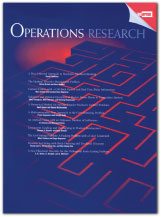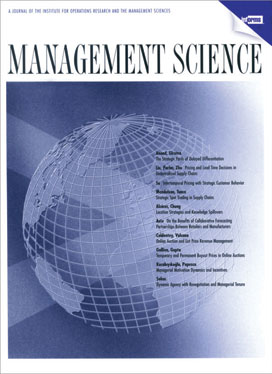Academic articles
Practitioner articles
Working papers
Books
Book chapters
Case studies
Other publications
Subject(s)
Human resources management/organizational behavior; Management sciences, decision sciences and quantitative methods
Keyword(s)
Change Management, Änderung, Sozialpsychologie, Organisationspsychologie
Secondary Title
Changemanagement: Theorie und Praxis
Pages
65–79
ISBN
978-3-938407-22-6
Subject(s)
Product and operations management
Keyword(s)
facilities/equipment planning capacity expansion, games noncooperative, inventory/production multi-item, queues priority
We consider a market with two suppliers and a set of buyers in search of procurement contracts with one of the suppliers. In particular, each buyer needs to process a certain volume of work, and each supplier's ability to process the customers' requests is constrained by a production capacity. The procurement contracts include guarantees that the products will be available when needed, and the buyers select a supplier based on their service delivery offers. The suppliers are modeled as make-to-stock queues and compete for the buyers' business. The main objective of this paper is to determine how the procurement contracts are established between buyers and suppliers. Because each buyer selects a single supplier to establish the sourcing relationship, the game fails to have a pure-strategy Nash equilibrium. Instead, an equilibrium is defined as the limit equilibrium of some discrete action games.
© 2008 INFORMS
Volume
56
Journal Pages
562–575
Subject(s)
Technology, R&D management
Keyword(s)
management consulting, service marketing, competitive strategy, marketing communication, sales organization
The article focuses on the developments in several B2B companies which traditionally produce goods and based on this experience are trying to enter the business of management consulting. It is the aim of the paper to identify the specific challenges that these companies are facing regarding marketing and selling their management consulting services. Furthermore hypotheses are developed that should give direction how to overcome those challenges successfully. Due to the lack of current research results, an explorative case study approach is chosen referring to two companies from the IT industry having gained relevant experience in this business area. In addition, theoretical frameworks demonstrate the plausibility of the hypotheses developed. If further research supports these hypotheses, it will have significant impact on the market strategy, marketing communication and sales organization of companies going to increase their consulting services.
With permission of Elsevier
Volume
37
Journal Pages
329–338
Subject(s)
Economics, politics and business environment
Keyword(s)
subsidies, European state aid control, competition policy, law and economics
JEL Code(s)
H 25 U21
Secondary Title
Handbook of antitrust economics
Pages
625–669
ISBN
978 0 262 02627 7
Subject(s)
Ethics and social responsibility
Keyword(s)
banking, ethics, conflict of interest, politics, leadership, crew resource management
This case describes the events that led to the near-collapse of Bankgesellschaft Berlin and the subsequent restructuring that was completed in July 2007. The state-owned bank was saved from failure by a capital injection of 1.8 billion euros and a guarantee for the covering of losses of up to 21.7 billion euros provided by the state of Berlin. These measures almost bankrupted the state of Berlin and had wide-ranging political consequences. The case therefore highlights the current problems of the German banking system, which is dominated by publicly-owned savings banks. The case covers the events of Bankgesellschaft Berlin between 1996 and 2006. It opens with Thomas Kurze, a member of the management board of Bankgesellschaft Berlin, in November 2000. He has to decide on a proposal for raising cash to prevent the looming collapse of the bank. The dilemma of Thomas Kurze is told from two angles: (1) the managerial angle focuses on saving the bank through recapitalisation or restructuring, and on the limits set by the co-determination of the supervisory board; and (2) the personal angle focuses on his individual responsibility to the bank versus the pressure and demands of the politicians involved. This includes the discussion of his personal values being in conflict with the bank. The case has students analyse the impact of a public shareholder with multiple interests on a major German bank, and the flawed governance structure of which has led it to near-collapse. Students will furthermore discuss the choices a business leader has when faced with this dilemma. The case was written entirely using publicly available information - especially information from public hearings and a special report of the Berlin parliament published in 2006.
| buy now |
Subject(s)
Marketing
Keyword(s)
consumer behavior, pricing, price partitioning, attention, information processing, framing effects, multi-attribute utility
Existing evidence suggests that preferences are affected by whether a price is presented as one all-inclusive expense or partitioned into a set of mandatory charges. To explain this phenomenon, we introduce a new mechanism whereby price partitioning affects a consumer's perception of the secondary (i.e., nonfocal) benefits derived from a transaction. Four experiments support the hypothesis that a partitioned price increases the amount of attention paid to secondary attributes tagged with distinct price components. Characteristics of the offered secondary attributes such as their perceived value, relative importance, and evaluability can therefore determine whether price partitioning stimulates or hinders demand. Beyond its descriptive and prescriptive implications, this theory contributes to the emerging notion that pricing can transform, as well as capture, the utility of an offer.
© 2008 INFORMS
Volume
27
Journal Pages
236–246
Subject(s)
Human resources management/organizational behavior
Keyword(s)
coaching, peer coaching, leadership development
Peer coaching in executive education programs is a developmental approach that uses a number of principles developed in executive coaching practice and research, and the power of work and life experience of fellow participants in helping other members of the class clarify their goals, assess the current reality of their situation and understand the forces that help or hinder goal achievement, elaborate available options or alternatives, identify necessary resources and support mechanisms, and, last but not least, commit to action through development and peer approval of an action plan and agreeing on a follow-up with the peer coach throughout the process of implementation of the action plan. This technical note serves as a resource for participants of leadership development programs involving elements of peer coaching.
With permission of Emerald
Volume
22
Journal Pages
15–24
Subject(s)
Product and operations management
Keyword(s)
call center, outsourcing, subcontracting, contract choice, capacity investment, pricing
This paper considers a call center outsourcing contract analysis and choice problem faced by a contractor and a service provider. The service provider receives an uncertain call volume over multiple periods and is considering outsourcing all or part of these calls to a contractor. Each call brings in a fixed revenue to the service provider. Answering calls requires having service capacity; thus implicit in the outsourcing decision is a capacity decision. Insufficient capacity implies that calls cannot be answered, which in turn means there will be a revenue loss. Faced with a choice between a volume-based and a capacity-based contract offered by a contractor that has pricing power, the service provider determines optimal capacity levels. The optimal price and capacity of the contractor together with the optimal capacity of the service provider determine optimal profits of each party under the two contracts being considered. This paper characterizes optimal capacity levels and partially characterizes optimal pricing decisions under each contract. The impact of demand variability and the economic parameters on contract choice are explored through numerical examples. It is shown that no contract type is universally preferred and that operating environments as well as cost-revenue structures have an important effect.
© 2008 INFORMS
Volume
54
Journal Pages
354–368
ISSN (Online)
1526-5501
ISSN (Print)
0025–1909
Subject(s)
Marketing
Keyword(s)
marketing assets, shareholder value
Volume
25
Journal Pages
14–17
Subject(s)
Finance, accounting and corporate governance
Keyword(s)
sovereign wealth funds, political risk, foreign direct investment
A growing share of inward investment into the European Union, including but not limited to sovereign wealth funds (SWFs), will come from countries with diverse political regimes with which Europeans may not always see eye-to-eye. The current crisis may increase both Europe's need for such investment and its sensitivity to the non-economic implications. New investor countries have incentives to refrain from political use of their assets, as illustrated by the recently published 'Santiago principles' for transparency and accountability of SWFs. But these incentives are not powerful enough to spare Europe its own assessment of security risks linked to new trends in foreign investment.
Pages
24
ISSN (Print)
1866–4024




